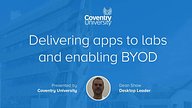Changing the way students access apps with BYOD at Coventry University

Delivering desktop applications to over 50,000 students isn't easy with traditional deployment methods. Learn how and why Coventry University chose AppsAnywhere to deploy apps on demand and improve the student IT and learning experience.
Coventry University have grown signifcantly over the last few years, to approximately 50,000 students across multiple campuses in the UK and overseas. At the same time, the University has seen remarkable progress within the UK higher education league tables, not least because of their forward-thinking and student-focussed approach.
With over 11,000 managed machines, the university IT team needed a way to deliver apps to all their end-users in a better way. They needed a solution which was more efficient for IT than the traditional deployment methods they were using, including SCCM, imaging and "sending a man around with a stick to install software".
On top of that, the solution needed to meet the needs and demands of the students, who these days expect to be able to use the devices they bring to university to do their work. And that expectation includes having access to all the university's specialist software, regardless of whether they bring Windows or Mac.
Learn more in the video below...
Changing the way students access app with BYOD - Video transcription
Stephen Booth: Coventry University has grown significantly over the last few years, and has actually advanced significantly up the league tables. We've grown to, roughly speaking, 50,000 students in the last five years. We deliver a wide range of courses, and we deploy them from a wide range of locations. So we have campuses in the UK, in Scarborough, in East London, in Central London, and we have growing presences overseas.
Total machines are around about 11,000. Roughly 85% of that is Windows, with the balance being Mac. We used to be based on a single physical environment, and you could send a man with a stick running around to install stuff. You can't do that anymore. We've got a number of campuses in the UK, we've got a number offices overseas. That kind of model doesn't work, so we've got to have a scalable global model that we can deploy things from a central base, but remotely.
We've then also got an increasingly diverse estate, so if you go back a number of years it was pretty much Windows. That's what you got. It's definitely now Windows and Mac, and there's increasing demand, certainly from research communities, for things like Linux. So the actual end device, the OS, the platform, you are less and less in control of, and students, as we all know, will bring whatever it is they bring, and want to work with that.
Dean Shaw: I think what attracted us to AppsAnywhere was the instant availability. It was allowing us to provide software, via the web page, that was instant. As soon as we provisioned it to the people, the users that was targeted, we could be safe in the knowledge that it was there and ready for them to use.
Stephen Booth: If I go back four/five years ago when we first looked at it now, we got a number of issues around the estate. One was simply cost, so we got multiple imaging platforms. Deployment of new applications was basically a question of re-imaging the entire machine, which meant you either did it infrequently or you were trying to run large jobs overnight and get them all to finish in time. So the whole thing was based on a static, unchanging, single campus model.
What attracted me to AppsAnywhere was the idea that actually you could start to break apart that desktop. So rather than thinking in terms of "Here's your image, that's what you've got", you take it down to a lower level of granularity, which is the application. And once you make that break, and make that change, you then can allow the end user to reassemble their desktop in whatever way they see fit. So if we've got a fixed managed machine, that's great, we can stream the apps to it as always. But if you're a student bringing your own laptop and you just want to consume a couple of applications, you can do that in your environment without having to take a fully managed lockdown service from us. So it's that flex, and that ability to mix the model.
Dean Shaw: The students, being what they are in this modern day with technology, is they just consume it. When you sell it as an app store, they get it. What the feedback we got was they just liked the fact they could go anywhere and use it. They liked the fact they could use it on their own desktop. And they also liked the fact that they didn't actually need to come into campus. We've actually got students that don't actually come to campus; they're based elsewhere.
Obviously, students that are out in the field, research. They may be working in partnership with another business or university. They will never set foot on this campus. And so for them, being able to access the likes of SPSS, they just go onto the web page, they've got an account, and they've got it, and they use it. Obviously, there's apps as well that we can provide where they can be used offline. So, again, we have students that work in areas of the countries where the wifi signals are poor. They will probably launch those apps when they have connection, knowing that they can then use them when there is no connection.
Stephen Booth: When we started this process a few years back we had a very clear set of aims, which were around flexible deployment, cost control, those sorts of things. And I think, by and large, we can say we've done that. And if we look where we are now, that was almost the easy bit. The next part of the journey we've got to go on, is actually we're now a global business with sites, with offices, with campuses throughout the UK and the rest of the world. And we need to deliver a service that scales, and is global. AppsAnywhere provides us the foundation to do that.
Related reading...

Delivering software to labs across campus and enabling BYOD at Coventry University
Watch Coventry University's recent presentation and learn how IT delivers apps to any computer across campus, while enabling BYOD and access to software on student-owned devices.

Durham University
Learn how Durham University have enabled student access to software on any device across campus (including macOS and Chromebooks) thanks to AppsAnywhere, Cloudpaging and Parallels RAS

Higher Ed across the UK leads the way on student BYOD, both on and off campus
Bring Your Own Device (BYOD) has been a hot topic of computing for over a decade now. In higher education however, it can be a complex set up. See how UK universities are conquering student BYOD.
Discover AppsAnywhere...

Improve student outcomes by delivering a better IT service, on and off campus. Make any app available on any device, enable BYOD and repurpose your dedicated lab spaces, all without the need for complex VDI environments.
If you're a student of Coventry University and you're trying to access software using AppsAnywhere, please click the button below.
If you're having issues with AppsAnywhere or are seeing error messages, please contact Coventry IT support by clicking the button below